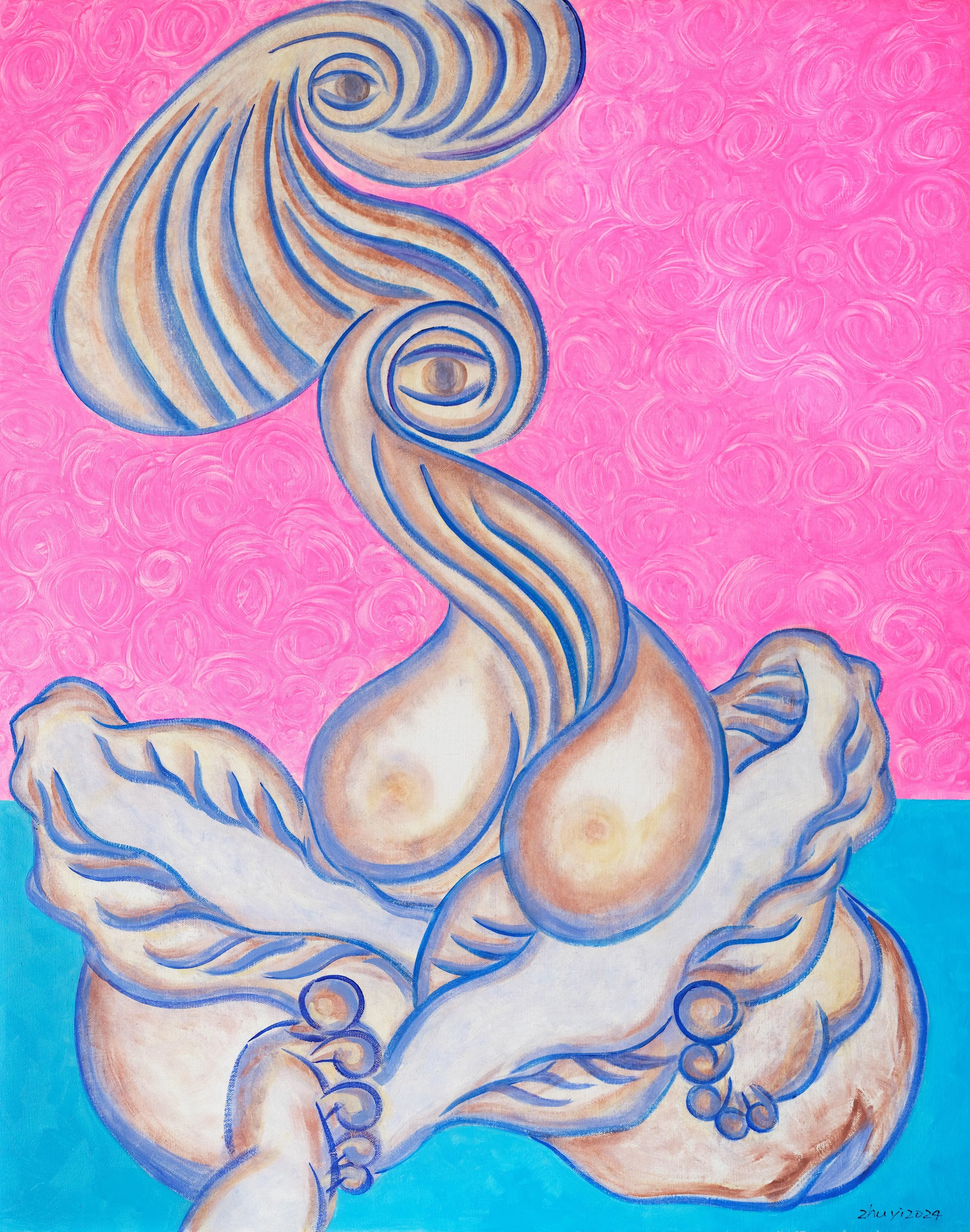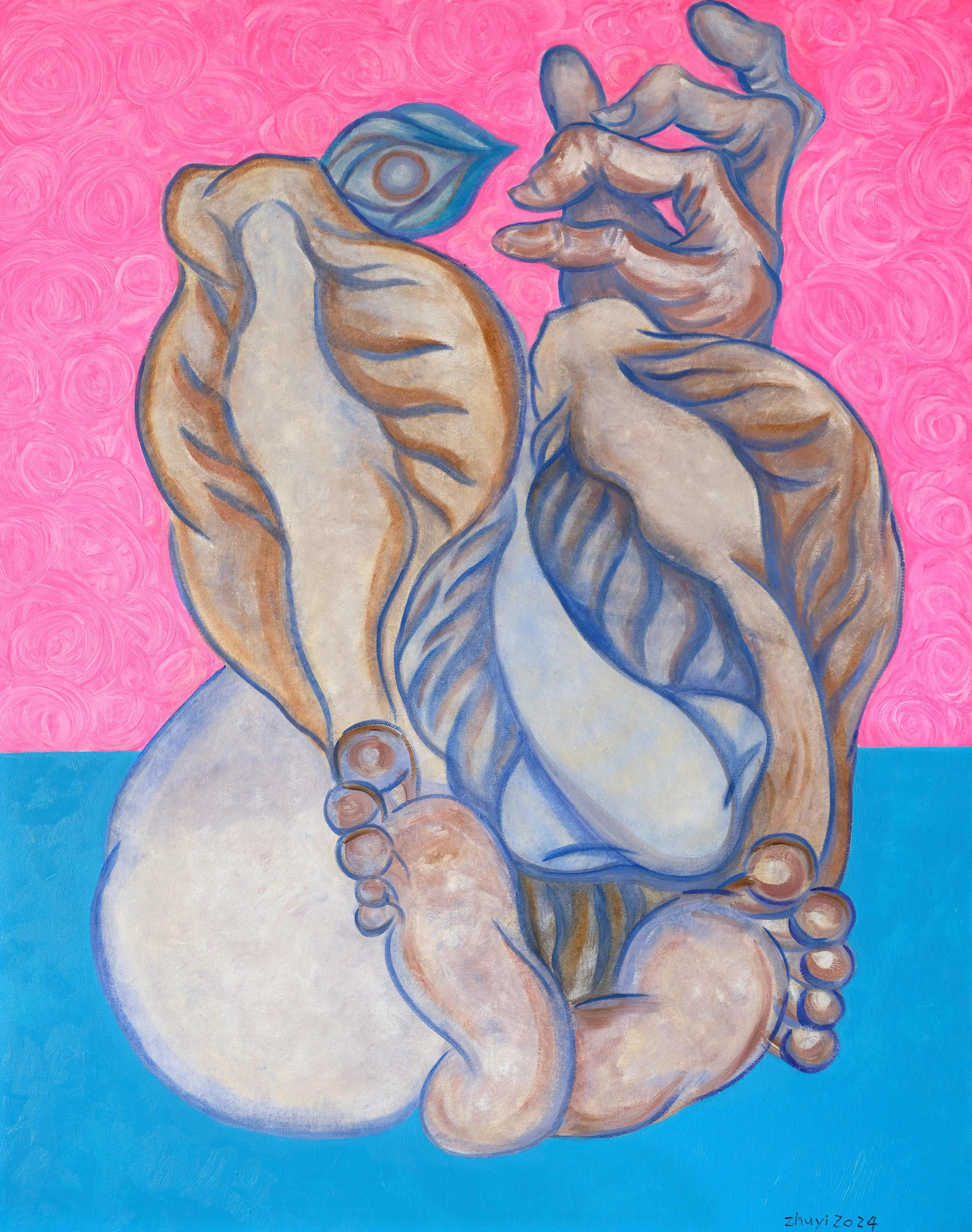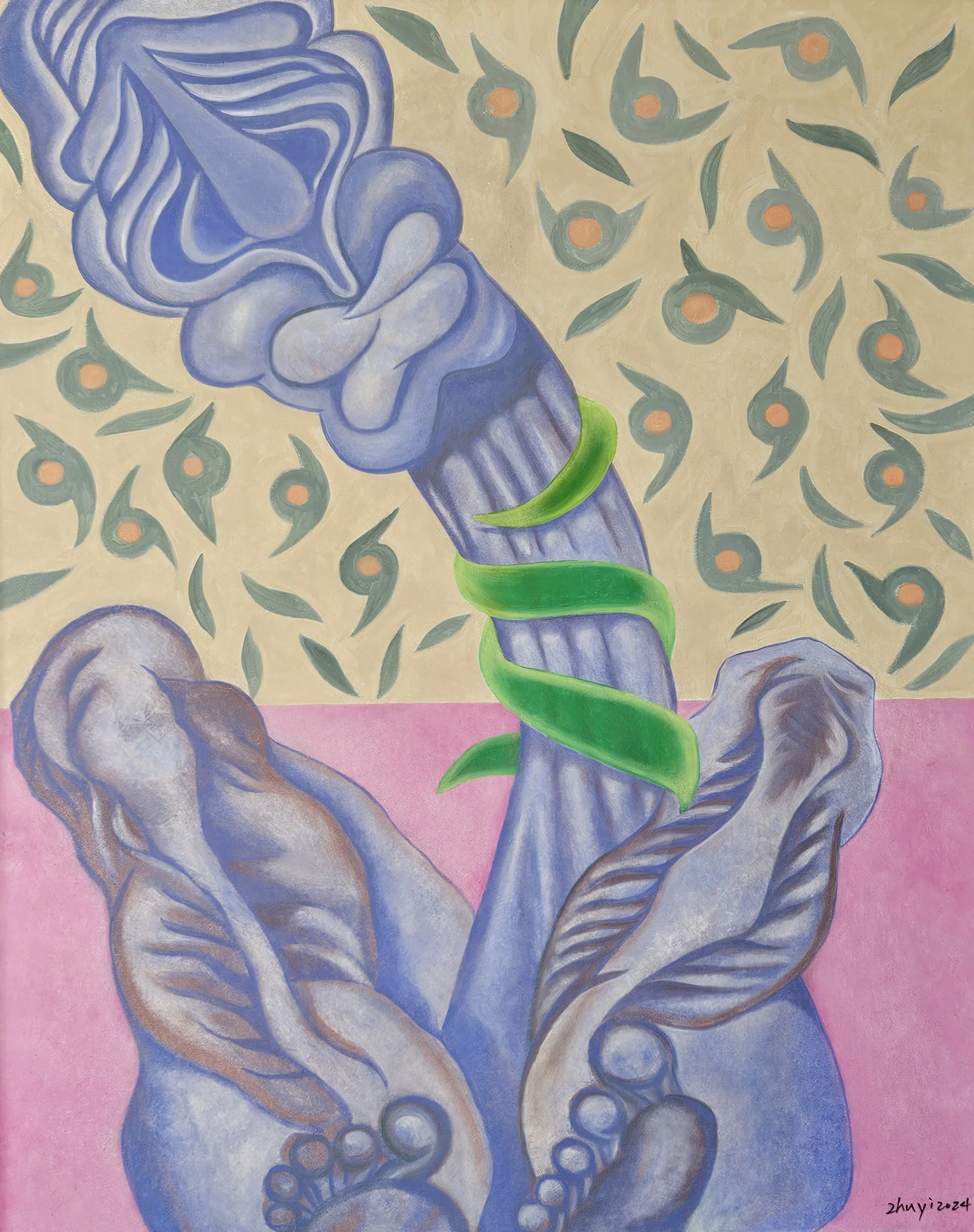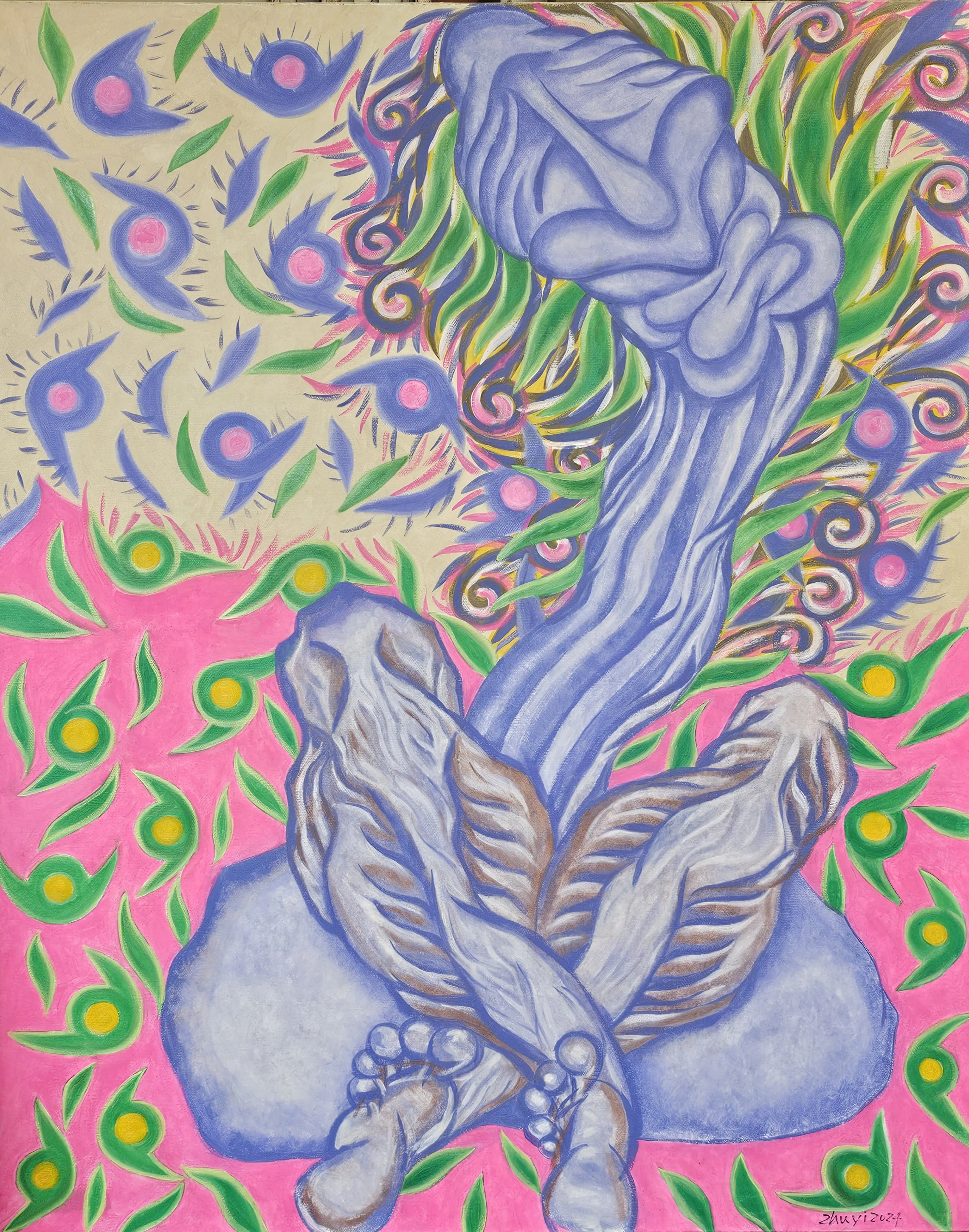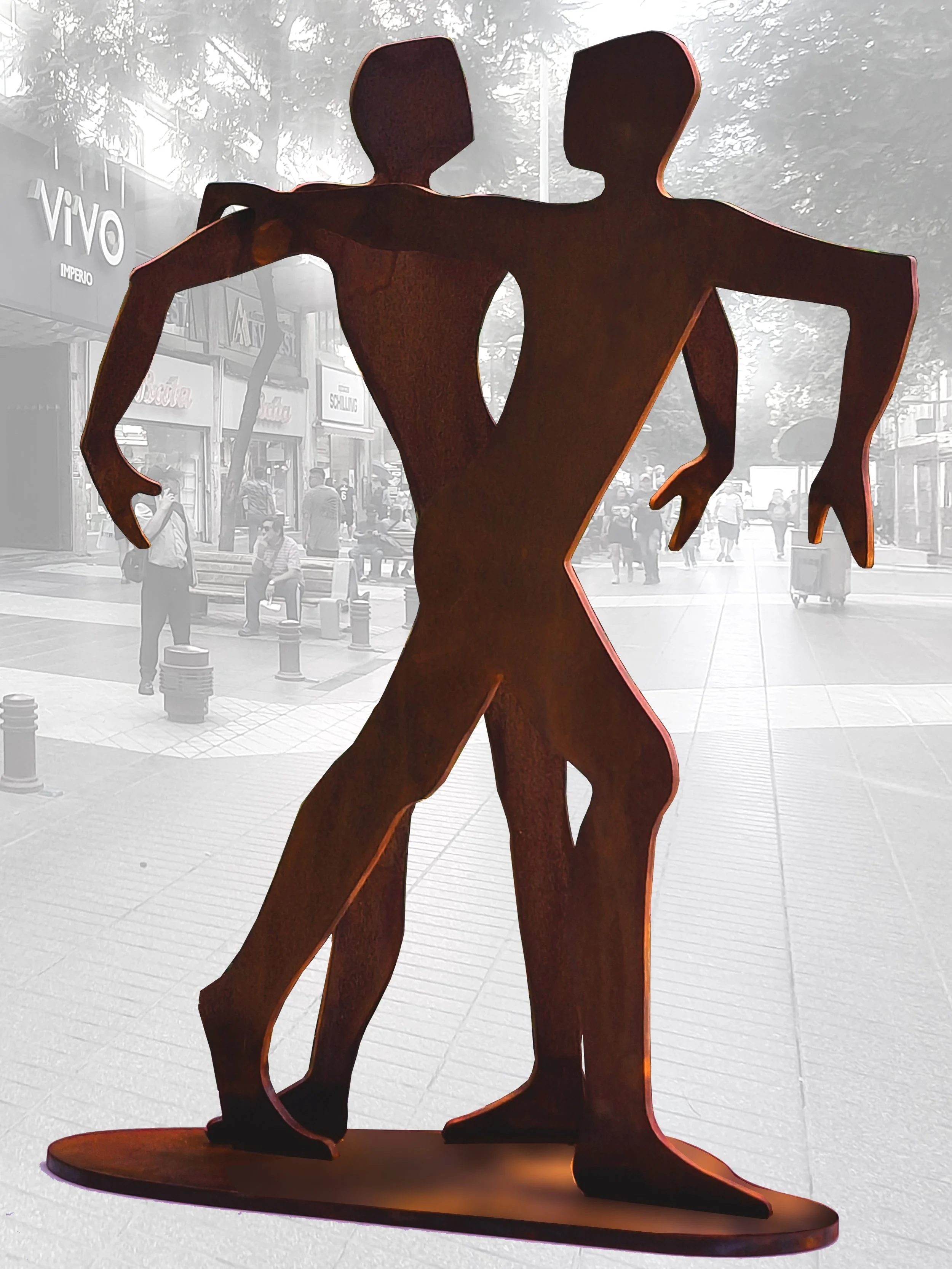Yi Zhu
Yi Zhu's work is a visceral plunge into the metaphysical realms, where the human experience is rendered through a lens both intimate and surreal. His recent series, including works like "Construct a State of Mind," "Disrespectful Intrusion," and "Posthuman Implant," create a dialogue between the abstract and the tangible, inviting viewers to confront and question the structural rigidity of the world. Zhu’s philosophy, influenced by deconstructivist and reconstructivist theories, shines through in each canvas, where deconstructed forms reassemble to present spiritual reflections, echoing Wittgenstein’s exploration of logic and Heidegger’s views on existentialism. He paints thoughts rather than objects, breathing life into his abstractions as he captures the essence of existence itself.
Each painting feels like a bold declaration of his artistic statement: “I’m not just painting. I’m painting thoughts.” In this sense, his canvases are not merely aesthetic objects but intellectual landscapes that challenge viewers to enter a new realm of perception. This is not a simple task for the viewer; Zhu’s work doesn’t accommodate passivity. Instead, it demands an active engagement as each shape and line appears meticulously constructed to disrupt normative expectations, probing at our understanding of form, self, and identity.
One of the more striking aspects of Zhu’s technique is his ability to fuse the organic with the mechanical, evoking imagery that feels both familiar and otherworldly. In works like "New Species" and "My World and This World," his use of vibrant colors and bold contours transforms limbs and forms into entities that are as human as they are alien. The exaggerated, sinewy lines and almost biological structures allude to the idea of human bodies transcending their physical limits, connecting to a collective consciousness or a universal life force. This impression is intensified by Zhu’s choice of bright, sometimes jarring colors, which disrupt the usual symbolism associated with bodily form, allowing the audience to envision a reconstructed human essence freed from societal constructs.
"Construct a State of Mind No. 01" exemplifies his approach to deconstructivism in a visually arresting manner. The painting unfolds as an exploration of interiority, as if Zhu is attempting to map out the contours of thought itself. The brushwork, with its undulating forms and rhythmic patterns, appears almost like synaptic pathways—a metaphor for the constant ebb and flow of human consciousness. The palette Zhu employs here is simultaneously soothing and unsettling, drawing the viewer into a space that feels both cerebral and deeply emotional. This is where his philosophy of art-as-thought becomes tangible; we aren’t looking at objects but rather at the manifestation of intangible ideas, frozen in moments of color and form.
In "Disrespectful Intrusion," Zhu brings another layer of complexity. Here, he confronts the viewer with imagery that suggests intrusion in both the physical and psychological sense. The forms, which at first glance resemble human limbs and organs, contort and merge in ways that feel almost invasive, as if Zhu is inviting us to examine the vulnerability of our own bodies. It’s a theme that runs through his work, this push-and-pull between exposure and concealment, where each piece offers a space for reflection on the corporeal and its inherent limitations. Zhu’s brushstrokes are expressive yet controlled, suggesting a kind of existential struggle, an attempt to capture the dignity of the human form while also acknowledging its fragility.
His interest in existentialism and time surfaces explicitly in "Posthuman Implant No. 01" and "No. 02," where he engages with themes of evolution and identity in the posthuman age. The works seem to question what it means to be human in an era where technological advancement increasingly blurs the boundaries between the organic and the artificial. The vibrant hues of pink, green, and blue intermingle with shapes that resemble bones and tendons, morphing into entities that are neither fully human nor fully machine. It’s as though Zhu is imagining a future where humanity has merged with its creations, yet retains an ineffable spirit that transcends physical augmentation. This is the paradox Zhu captures so eloquently: the sense of losing and rediscovering self within the same stroke.
One of Zhu’s most compelling strengths lies in his ability to render movement within his compositions. His works seem to breathe, pulse, and undulate, embodying his concept of life’s expansion and contraction as an echo of existence itself. This is especially palpable in the "New Species" series, where limbs and body parts twist in unnatural yet oddly harmonious ways. Zhu isn’t interested in painting anatomical accuracy; rather, he seeks to portray the essence of life—the ways it bends, stretches, and persists despite external pressures. His compositions evoke a sense of continuous transformation, of bodies in flux, suggesting that identity itself is an ongoing process of construction and deconstruction.
Another notable element is his use of background patterns, which often appear as a tapestry of organic motifs that mimic cellular structures or botanical patterns. This detail grounds his work in the natural world, even as his forms verge on the alien. It’s as if Zhu is suggesting that all life—human, plant, or otherwise—shares an underlying rhythm, a common origin. The backgrounds aren’t mere backdrops; they’re integral to the compositions, reinforcing Zhu’s philosophy that the material and the abstract are interconnected, constantly influencing one another.
"Construct a State of Mind No. 03" is another thought-provoking piece where Zhu’s deconstructive approach reaches its zenith. The work feels like a visualized meditation, with swirling shapes that seem to mimic the act of thinking itself. Zhu’s choice of color—a medley of blues, greens, and pinks—lends a sense of calm to the piece, though it’s an uneasy calm, as if he’s capturing the tension between clarity and chaos that exists within every mind. The forms here are less corporeal than in his other works, leaning more towards abstraction, yet they retain an essence of the human, as though they are thought-forms, residues of experiences that have coalesced into shapes. It’s a fascinating approach that blurs the lines between self and thought, between observer and observed.
In his other works, like "My World and This World No. 02," there’s a sense of maturity and subtlety that contrasts with the raw energy of his earlier paintings. Zhu’s brushwork here is more refined, his color choices more deliberate, and the overall composition more cohesive. It’s as though he’s arrived at a deeper understanding of his own philosophy, embodying it with a confidence that allows him to explore subtler nuances within his framework of deconstruction and reconstruction. The piece invites viewers to reflect on the intersection between individual identity and collective experience, as Zhu skillfully weaves together fragments of both the self and the world into a singular vision.
"New Species No. 01" captures Yi Zhu’s fascination with organic forms that verge on the surreal, invoking an almost alien quality in its depiction of anatomy. The painting's palette is vibrant yet grounded, combining cool blues and greens with accents of pink that draw the eye to the central forms. The composition feels both scientific and dreamlike, as though Zhu is dissecting and reconstructing the essence of life itself. There’s a palpable tension between recognition and mystery here; while the shapes evoke elements of human anatomy, they twist and spiral in ways that feel unfamiliar, pushing the viewer to question the boundaries between human and non-human.
This piece might be read as Zhu’s commentary on evolution—his vision of what humanity could become, liberated from traditional physical constraints. The shapes seem to stretch and pull away from one another, perhaps representing a disconnection or transformation from the original form. Yet, this separation does not imply a loss of connection to the human experience. Rather, Zhu is suggesting that the essence of life, the “new species” he is creating, is still intrinsically bound to the fundamental experiences of survival and adaptation.
In "New Species No. 02," Zhu’s exploration becomes even more abstract, venturing into the realm of biomorphism. The forms are softer here, with swirling, fluid lines that resemble tendrils or biological structures under a microscope. Unlike "New Species No. 01," which feels grounded in physical reality, this painting drifts into a more ephemeral space, as if Zhu is mapping out the evolution of thought rather than physical forms. His choice of colors here—soft blues, gentle greens, and bright accents—imbues the piece with a sense of organic growth, as if life itself is spiraling forth from the canvas.
This piece seems to represent the genesis of something entirely new, a species that exists beyond traditional definitions. It’s an exploration of potentiality, a visual meditation on the myriad ways life can manifest. Zhu’s deft use of abstraction here emphasizes his commitment to deconstructing not only material forms but also conceptual boundaries. By doing so, he invites the viewer to contemplate what it truly means to be “alive.” Are we defined by our bodies, our minds, or something altogether more ethereal?
“Disrespectful Intrusion No. 02” is one of Zhu’s more intense and confrontational pieces. The forms are intertwined and twisted, giving a sense of both intimacy and violation, as though boundaries have been crossed. His use of color here—stark contrasts of fleshy tones, sharp greens, and shadowy grays—conveys a certain tension, a feeling of discomfort that’s hard to shake. The shapes appear to be in conflict, pressing against one another in ways that suggest intrusion, yet there’s a deliberate ambiguity as to who or what is intruding upon whom.
This painting seems to explore the fragility of personal space and autonomy, addressing themes of vulnerability and exposure. In a world where boundaries are frequently crossed—whether through technology, surveillance, or social dynamics—Zhu’s work feels timely and relevant. The forms, though abstracted, resonate on a deeply visceral level, perhaps reflecting the ways we internalize and protect our personal boundaries. "
Disrespectful Intrusion No. 02" stands as a reminder of the delicate balance between connection and intrusion, where closeness can sometimes morph into a form of encroachment. It’s an unsettling piece, but in its discomfort, it speaks to universal human experiences.
“My World and This World No. 01” embodies Zhu’s overarching philosophy with remarkable clarity, depicting two “worlds” as intertwining forms that both converge and stand apart. The painting features a symphony of earthy tones mixed with vibrant pops of color, creating a sense of duality—of the personal world coexisting with the external. The forms here are reminiscent of body parts, yet Zhu abstracts them just enough to keep them ambiguous, inviting viewers to project their own interpretations onto the shapes.
In this work, Zhu presents the idea that each individual exists within their own self-constructed reality, even as they participate in a shared external world. The forms twist and overlap, suggesting points of intersection where one world bleeds into the other. It’s a subtle but powerful visual metaphor for the ways our inner lives are continuously shaped by the outside world—and vice versa. The choice of colors emphasizes this dialogue between worlds: warm hues representing personal comfort and identity, while cooler shades hint at external pressures and societal expectations. The viewer is left to ponder the delicate balance required to maintain individuality in a world that often demands conformity.
What stands out about these works is the sense of coherence Zhu achieves, despite the radical differences in form and style across his paintings. Each piece feels like a fragment of a larger conversation, one that explores the boundaries between self and other, human and non-human, material and abstract. His deconstructivist approach allows him to pull apart the familiar and reassemble it in new and startling ways, evoking the complexities of human existence.
Zhu’s work resists easy interpretation, and that is part of its allure. His paintings do not simply depict subjects; they conjure experiences, emotions, and thoughts that linger long after one has left the gallery. His use of vibrant colors, twisting forms, and layered textures all contribute to an atmosphere that is as captivating as it is challenging. Zhu's works are not mere exercises in aesthetics; they are philosophical investigations rendered in paint, where each brushstroke is a proposition, and each composition a meditation on the nature of existence.
Through pieces like "New Species No. 01" and "No. 02," "Disrespectful Intrusion No. 02," and "My World and This World No. 01," Zhu reveals his capacity to straddle the line between materiality and spirituality, capturing the intangible essence of human thought and emotion. His art reflects his belief in deconstructing rigid structures and redefining life through abstracted forms that breathe and evolve. In doing so, Zhu not only questions the boundaries that define our world but also encourages viewers to reflect on the constructs that define their own lives.
Yi Zhu's paintings invite us into a world where form and meaning are constantly in flux, a world where the rigid dissolves and new possibilities emerge. By challenging the conventions of both the physical and the spiritual, Zhu's work embodies a radical freedom—a freedom to imagine, to deconstruct, and to reconstruct. And in this freedom, we find not only a new understanding of art but also, perhaps, a new understanding of ourselves.
Yi Zhu’s work stands as a testament to the power of art to transcend conventional language. His paintings don’t merely represent; they evoke, provoke, and resonate, reaching into the viewer’s subconscious to elicit an almost instinctual response. In his canvases, materiality dissolves into abstraction, only to re-emerge as a spiritual force that bridges the gap between the virtual and the real. This is deconstructivism and reconstructivism at its most potent, where each brushstroke feels like a deliberate act of questioning, a challenge to the viewer to see beyond the familiar, to confront their own assumptions about form, body, and spirit.
In Zhu’s own words, “Because of my paintings, you see yourself.” It’s a bold claim, but one that feels entirely justified. His work invites us to do more than observe; it calls us to engage, to reflect, and ultimately, to recognize fragments of our own experience within the forms he has so masterfully constructed and deconstructed. Through his unique approach, Zhu not only redefines the boundaries of painting but also expands the potential of visual language to express the ineffable intricacies of human consciousness.
By Marta Puig
Editor Contemporary Art Curator Magazine
Disrespectful intrusion No.01 2023 Oil on canvas 60x80 CM
Disrespectful intrusion No.02 2023 Oil on canvas 60x80 CM
My world and this world No.01 2024 Oil on canvas 80x100 CM
My world and this world No.02 2024 Oil on canvas 80x100 CM
Construct a state of mind No. 01 2024 Oil on canvas 80x100 CM
Construct a state of mind No. 03 2024 Oil on canvas 80x100 CM
New species No.01 2024 Oil on canvas 60x80 CM
New species No.02 2023 Oil on canvas 60x80 CM
Posthuman implant No.01 2024 Oil on canvas 80x100 CM
Posthuman implant No.02 2024 Oil on canvas 80x100 CM




